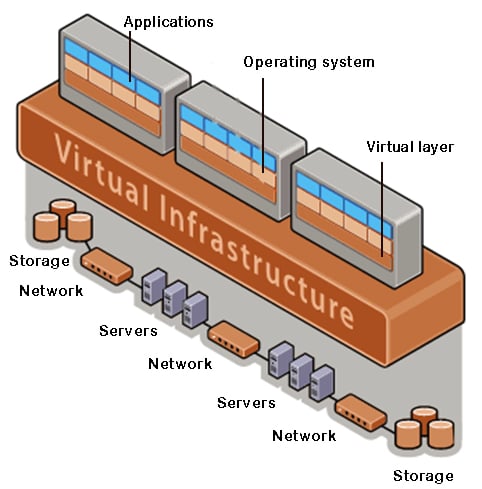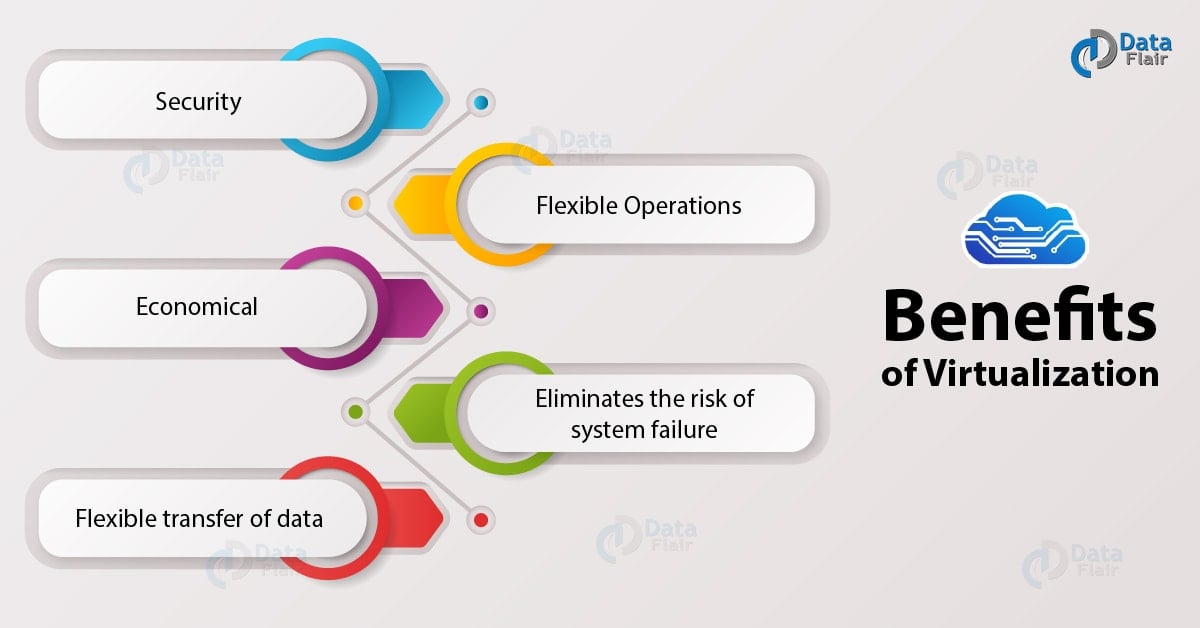Virtualization in Cloud Computing – Benefits & Types of Virtualization
Free AWS Course for AWS Certified Cloud Practitioner (CLF-C01) Start Now!!
The last session was all about Community Cloud. Here, we come up with a new concept called Virtualization in Cloud Computing, in which we will explore its working. Along with this, we will learn the types and advantages of Virtualization.
So, let’s begin the Cloud Virtualization Tutorial.
What is Virtualization in Cloud Computing?
Virtualization in Cloud Computing is making a virtual platform of server operating system and storage devices. This will help the user by providing multiple machines at the same time it also allows sharing a single physical instance of resource or an application to multiple users.
Cloud Virtualizations also manage the workload by transforming traditional computing and make it more scalable, economical and efficient.
Virtualizations in Cloud Computing rapidly integrating the fundamental way of computing. One of the important features of virtualization is that it allows sharing of applications to multiple customers and companies.
Cloud Computing can also be known as services and application delivered to help the virtualized environment. This environment can be either public or private. With the help of virtualization, the customer can maximize the resources and reduces the physical system which is in need.
Types of Virtualization in Cloud Computing
- Operating System Virtualization
- Hardware Virtualization
- Server Virtualization
- Storage Virtualization
Do you know What is the Challenges of Cloud Computing?
a. Operating System Virtualization
In operating system virtualization in Cloud Computing, the virtual machine software installs in the operating system of the host rather than directly on the hardware system.
The most important use of operating system virtualization is for testing the application on different platforms or operating system. Here, the software is present in the hardware, which allows different applications to run.
b. Server Virtualization
In server virtualization in Cloud Computing, the software directly installs on the server system and use for a single physical server can divide into many servers on the demand basis and balance the load.
It can be also stated that the server virtualization is masking of the server resources which consists of number and identity. With the help of software, the server administrator divides one physical server into multiple servers.
c. Hardware Virtualization
Hardware virtualization in Cloud Computing, used in server platform as it is flexible to use Virtual Machine rather than physical machines. In hardware virtualizations, virtual machine software installs in the hardware system and then it is known as hardware virtualization.
It consists of a hypervisor which use to control and monitor the process, memory, and other hardware resources. After the completion of hardware virtualization process, the user can install the different operating system in it and with this platform different application can use.
d. Storage Virtualization
In storage virtualization in Cloud Computing, a grouping is done of physical storage which is from multiple network storage devices this is done so it looks like a single storage device.
It can implement with the help of software applications and storage virtualization is done for the backup and recovery process. It is a sharing of the physical storage from multiple storage devices.
How Virtualization Works?
Virtualization in Cloud Computing is a process in which the user of cloud shares the data present in the cloud which can be application software etc. It provides a virtual environment in the cloud which can be software hardware or any other thing.
In virtualization, the server and the software application which are required by the cloud providers maintain by the third party and in this, the cloud provider please some amount to the third party.
It is done because it will be costly if a new version of an application is released and it has to be introduced to the customers.
It can be also explained in a way that with the help of Hypervisor which is software the cloud customer can access server. A hypervisor is connectivity between the server and the virtual environment and distributes the resources between different virtual environments.
Benefits of Virtualization
Virtualizations in Cloud Computing has numerous benefits, let’s discuss them one by one:
i. Security
During the process of virtualization security is one of the important concerns. The security can be provided with the help of firewalls, which will help to prevent unauthorized access and will keep the data confidential.
Moreover, with the help of firewall and security, the data can protect from harmful viruses malware and other cyber threats. Encryption process also takes place with protocols which will protect the data from other threads.
So, the customer can virtualize all the data store and can create a backup on a server in which the data can store.
ii. Flexible operations
With the help of a virtual network, the work of it professional is becoming more efficient and agile. The network switch implement today is very easy to use, flexible and saves time.
With the help of virtualization in Cloud Computing, technical problems can solve in physical systems. It eliminates the problem of recovering the data from crashed or corrupted devices and hence saves time.
Let’s revise What are Cloud Operations?
iii. Economical
Virtualization in Cloud Computing, save the cost for a physical system such as hardware and servers. It stores all the data in the virtual server, which are quite economical.
It reduces the wastage, decreases the electricity bills along with the maintenance cost. Due to this, the business can run multiple operating system and apps in a particular server.
iv. Eliminates the risk of system failure
While performing some task there are chances that the system might crash down at the wrong time. This failure can cause damage to the company but the virtualizations help you to perform the same task in multiple devices at the same time.
The data can store in the cloud it can retrieve anytime and with the help of any device. Moreover, there is two working server side by side which makes the data accessible every time. Even if a server crashes with the help of the second server the customer can access the data.
v. Flexible transfer of data
The data can transfer to the virtual server and retrieve anytime. The customers or cloud provider don’t have to waste time finding out hard drives to find data. With the help of virtualization, it will very easy to locate the required data and transfer them to the allotted authorities.
This transfer of data has no limit and can transfer to a long distance with the minimum charge possible. Additional storage can also provide and the cost will be as low as possible.
So, this was all about Cloud Virtualization Tutorial. Hope you like our explanation.
Conclusion
With the help of Virtualization in Cloud Computing, companies can implement cloud computing. This article proves that virtualization in Cloud Computing is an important aspect in cloud computing and can maintain and secure the data.
Furthermore, if you have any query, feel free to ask in the comment tab.
Your opinion matters
Please write your valuable feedback about DataFlair on Google






nice..
Well said! This is really a nice blog to check on..